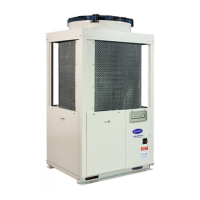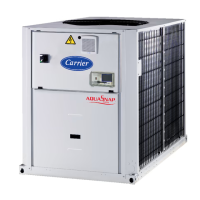30RB/30RQ
GB - 6
General information and hydronic module
Unit installation
Read this manual thoroughly before starting machine installation.
The device complies with the low voltage directives, Machinery
Directive and EMC Directive.
• The installation must be carried out by a quali ed installer.
• Follow all current national safety code requirements.
In particular ensure that a properly sized and connected ground
wire is in place.
• Check that voltage and frequency of the mains power supply are
those required; the available power must be adequate to operate
any other possible appliances connected to the same line.
Also ensure that national safety code requirements have been
followed for the mains supply circuit.
• After installation thoroughly test the system operation and explain
all system functions to the owner.
• Leave this manual with the owner for consultation during future
periodic maintenance.
• Be sure the unit and its components are checked periodically to
look for loosen, damaged or broken components.
In case of persisting defects, the unit may cause personal injury or
property damage.
IMPORTANT:
During the unit installation make rst the hydronic connections
and then electrical connections. If unit is uninstalled rst
disconnect electrical cables, then the hydronic connections.
WARNING:
Disconnect the mains power supply switch before servicing the
system or handling any internal parts of the unit.
All mains supply circuits must be disconnected.
• The manufacturer declines any liability for damage resulting from
modi cations or errors in the electrical or hydronic connections.
• Failure to observe the installation instructions or use of the unit
under conditions other than those indicated in Tables “Operating
limits”, will immediately void the unit warranty.
• Failure to observe electric safety codes may cause a re hazard in
case of short circuits.
• Inspect equipment for damage due to improper transportation or
handling: le an immediate claim with the shipping company.
Do not install or use damaged units.
• During unit operation, some of the refrigerant circuit elements
could reach a temperature in excess of 70
o
C so only trained and
quali ed personnel should access areas protected by access
panels.
• In case of any malfunctioning turn the unit o , disconnect the
mains power supply and contact a quali ed service engineer.
• All of the manufacturing and packaging materials used for
your new appliance are compatible with the environment and
can be recycled.
• Dispose of the packaging material in accordance with local
requirements.
• This equipment contains refrigerant R-410A that must be
disposed of in a proper manner. When disposing of the unit
after its operational life, remove it carefully. The unit must then
be delivered to an appropriate disposal center or to the original
equipment dealer.
• Carefully recover refrigerant within this unit before nal disposal
or when servicing. Never vent refrigerant to atmosphere.
Choosing the installation site
• This unit should not be installed in an explosive atmosphere.
• The unit can operate in normal radioelectric atmospheres in
residential, commercial and light industrial installations.
For other applications, please consult Carrier.
• In the case of heat pump operation with an outdoor temperature
of less than 0 °C the unit must be installed at least 300 mm above
ground level.
This is necessary to prevent ice from accumulating on the frame
and to permit correct operation also in the event of heavy snowfalls.
The unit must be levelled on both axes (the tolerance is less than
2 mm per metre).
• In some cases it may be necessary to t de ectors against strong
winds and to stop snow from hitting the coil directly.
These de ectors must be installed so that the normal air
circulation is not obstructed.
Siting the unit
Check that:
- The location is able to support unit operating weight (Table I).
- There is su cient space for servicing and air ow around the unit
(see “Clearances” gure).
- The selected site is without dust or foreign material which could
obstruct the coil.
- When installing the unit on the ground, the selected site is not
subject to ooding.
- The installation is in accordance with local rules and standards
governing the installation of air conditioning equipment.
- Vibration absorbers have been provided throughout the
installation to prevent noise from being transmitted.
Transport
1. Use spreader bars to lift the unit to avoid damage to the panels.
Avoid violent movements.
2. Never roll or swing the unit more than 15°.
IMPORTANT:
Ensure that all unit panels are xed in place before moving the unit.
Raise and set down the unit carefully.
IMPORTANT:
Always ensure that the unit is levelled correctly.

